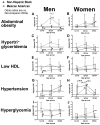Racial/ethnic discrepancies in the metabolic syndrome begin in childhood and persist after adjustment for environmental factors
- PMID: 20708390
- PMCID: PMC2988107
- DOI: 10.1016/j.numecd.2010.05.006
Racial/ethnic discrepancies in the metabolic syndrome begin in childhood and persist after adjustment for environmental factors
Abstract
Background and aims: Evaluation of metabolic syndrome (MetS) characteristics across an age spectrum from childhood to adulthood has been limited by a lack of consistent MetS criteria for children and adults and by a lack of adjustment for environmental factors. We used the pediatric and adult International Diabetes Federation (IDF) criteria to determine whether gender-specific and race-specific differences in MetS and its components are present in adolescents as in adults after adjustment for socio-economic status (SES) and lifestyle factors.
Methods and results: Waist circumference, blood pressure, triglycerides, HDL cholesterol, and fasting glucose measures were obtained from 3100 adolescent (12-19 years) and 3419 adult (20-69 years) non-Hispanic white, non-Hispanic black, and Mexican-American participants of the 1999-2006 National Health and Nutrition Examination Surveys. We compared odds of having MetS and its components across racial/ethnic groups by age group, while adjusting for income, education, physical activity and diet quality. After adjusting for possible confounding influences of SES and lifestyle, non-Hispanic-black adolescent males exhibited a lower odds of MetS and multiple components (abdominal obesity, hypertriglyceridemia, low HDL, hyperglycemia) compared to non-Hispanic-white and Mexican-American adolescents. Compared to non-Hispanic-white adolescent males, Mexican-American adolescent males had less hypertension. There were no differences in MetS prevalence among adolescent females, though non-Hispanic-black girls exhibited less hypertriglyceridemia.
Conclusion: Racial/ethnicity-specific differences in MetS and its components are present in both adolescence and adulthood, even after adjusting for environmental factors. These data help strengthen arguments for developing racial/ethnic-specific MetS criteria to better identify individuals at risk for future cardiovascular disease.
Copyright © 2010 Elsevier B.V. All rights reserved.
Figures

References
-
- Weiss R, Dziura J, Burgert TS, Tamborlane WV, Taksali SE, Yeckel CW, Allen K, Lopes M, Savoye M, Morrison J, Sherwin RS, Caprio S. Obesity and the metabolic syndrome in children and adolescents. N Engl J Med. 2004;350:2362–2374. - PubMed
-
- Reaven GM. Banting lecture 1988. Role of insulin resistance in human disease. Diabetes. 1988;37:1595–1607. - PubMed
-
- DeBoer MD, Gurka MJ. Ability among adolescents for the metabolic syndrome to predict elevations in factors associated with type 2 diabetes and cardiovascular disease: Data from the National Health and Nutrition Examination Survey (NHANES) 1999-2006. Metabolic Syndrome and Related Disorders. 2010 In Press. - PMC - PubMed
-
- Johnson WD, Kroon JJ, Greenway FL, Bouchard C, Ryan D, Katzmarzyk PT. Prevalence of risk factors for metabolic syndrome in adolescents: National Health and Nutrition Examination Survey (NHANES), 2001-2006. Arch Pediatr Adolesc Med. 2009;163:371–377. - PubMed
Publication types
MeSH terms
Substances
Grants and funding
LinkOut - more resources
Full Text Sources
Medical

